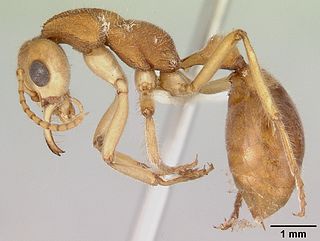
Myrmeciinae is a subfamily of the Formicidae, ants once found worldwide but now restricted to Australia and New Caledonia. This subfamily is one of several ant subfamilies which possess gamergates, female worker ants which are able to mate and reproduce, thus sustaining the colony after the loss of the queen. The Myrmeciinae subfamily was formerly composed of only one genus, Myrmecia, but the subfamily was redescribed by Ward & Brady in 2003 to include two tribes and four genera: An additional three genera, one form genus, and 9 species were described in 2006 from the Early Eocene of Denmark, Canada, and Washington.

Nothomyrmecia, also known as the dinosaur ant or dawn ant, is a rare genus of ants consisting of a single species, Nothomyrmecia macrops. These ants live in South Australia, nesting in old-growth mallee woodland and Eucalyptus woodland. The full distribution of Nothomyrmecia has never been assessed, and it is unknown how widespread the species truly is; its potential range may be wider if it does favour old-growth mallee woodland. Possible threats to its survival include habitat destruction and climate change. Nothomyrmecia is most active when it is cold because workers encounter fewer competitors and predators such as Camponotus and Iridomyrmex, and it also increases hunting success. Thus, the increase of temperature may prevent them from foraging and very few areas would be suitable for the ant to live in. As a result, the IUCN lists the ant as Critically Endangered.

Monomorium is a genus of ants in the subfamily Myrmicinae. As of 2013 it contains about 396 species. It is distributed around the world, with many species native to the Old World tropics. It is considered to be "one of the more important groups of ants," considering its widespread distribution, its diversity, and its variety of morphological and biological characteristics. It also includes several familiar pest species, such as the pharaoh ant and the flower ant.

Acropyga is a genus of small formicine ants. Some species can be indirect pests. A. acutiventris, which is found from India to Australia, tends subterranean, root-feeding mealybugs of the species Xenococcus annandalei. Living, gravid females are carried in the jaws of A. acutiventris queens during their nuptial flight, to establish the symbiotic association in founding colonies. Other Acropyga species have relationships with different species of mealybugs, and it could be a trait common to the whole genus.
John S. Clark was a Scottish-born Australian entomologist and myrmecologist known for his study of Australian ants. Born in Glasgow, he developed an interest in entomology at a young age. Clark first arrived in Australia in 1905 and originally worked for the state railways in Queensland. He developed an interest in ants shortly afterwards, collecting his first specimens in North Queensland. He married his first wife, Maggie Forbes in 1908, bearing four children, until her death in 1935. He married his second wife, Phyllis Marjorie Claringbulls in 1939 and had two daughters with her until she committed suicide in 1943. As a result, Clark sent his daughters to an orphanage.
Austromorium hetericki is an Australian species of ant in the genus Austromorium. It is only found in Western Australia. Little is known about their biology.
Myrmecia pavida is a bull ant species which lives in and is native to Australia. Described by John S. Clark in 1951, the Myrmecia pavida is distributed and has been mainly collected from the states of Western Australia and South Australia.

Prionomyrmecini is an ant tribe belonging to the subfamily Myrmeciinae established by William Morton Wheeler in 1915. Two members are a part of this tribe, the extant Nothomyrmecia and the extinct Prionomyrmex. The tribe was once considered a subfamily due to the similarities between Nothomyrmecia and Prionomyrmex, but such reclassification was not widely accepted by the scientific community. These ants can be identified by their long slender bodies, powerful stingers and elongated mandibles. Fossil Prionomyrmecini ants were once found throughout Europe, possibly nesting in trees and preferring jungle habitats. Today, Prionomyrmecini is only found in Australia, preferring old-growth mallee woodland surrounded by Eucalyptus trees. Nothomyrmecia workers feed on nectar and arthropods, using their compound eyes for prey and navigational purposes. Owing to their primitive nature, they do not recruit others to food sources or create pheromone trails. Nothomyrmecia colonies are small, consisting of 50 to 100 individuals.

Xymmer is a genus of ant in the subfamily Amblyoponinae containing the single species Xymmer muticus.

Myrmecia arnoldi is a bull ant of the Myrmecia genus. Like all bull ants except for one species in this genus, the Myrmecia arnoldi is native to Australia.

Myrmecia elegans is an Australian ant which belongs to the Myrmecia genus. It is a native species to Australia. The Myrmecia elegans is distributed in the more western states and regions of the country.
Myrmecia fulgida is an Australian ant which belongs to the Myrmecia genus. This species is native to Australia. Their distribution mostly in Western Australia and some areas of the east of Australia.

Myrmecia froggatti is an Australian ant which belongs to the Myrmecia genus. This species is native to Australia. This species is distributed throughout all areas of New South Wales and elsewhere up north and south.
Myrmecia michaelseni is an Australian ant which belongs to the Myrmecia genus. This species is native to Australia. They are mostly distributed and studied in Western Australia.
Iridomyrmex dromus is a species of ant in the genus Iridomyrmex. Described by John S. Clark in 1938, the ant is a nocturnal species that is distributed nationwide in Australia, commonly found in habitats such as desert, dry sclerophyll and rainforests in Tasmania.
Dolichoderus angusticornis is a species of ant in the genus Dolichoderus. Described by John S. Clark in 1930, the species is endemic to Australia, found in dry scrub heath in Western Australia and South Australia. Workers are diurnal and foraging during the day and at night.











